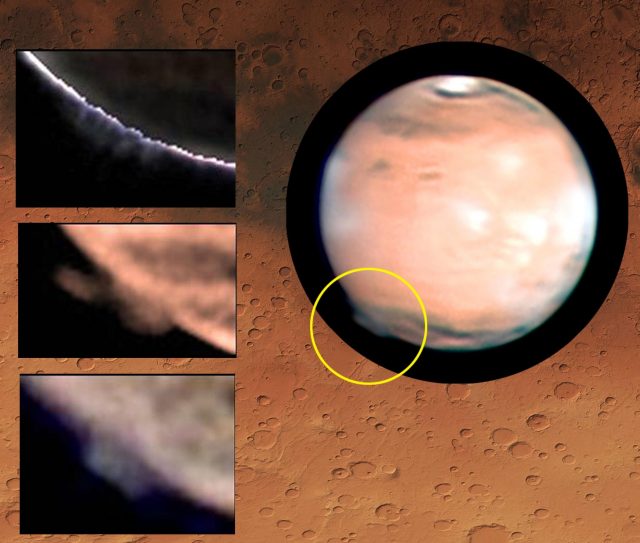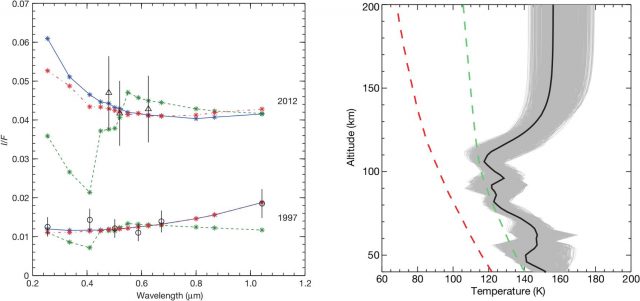The dawn plume looming over Terra Cimmeria

In 2012, some amateur astronomers reported the sighting of an unheard-of event: what was then called a cloud at the Martian limb apparently higher than 200 km above the planet’s surface. Such report received some attention from the mass media, particularly at the internet, but went mostly unnoticed among the professional community. However, the Planetary Sciences Group at the UPV/EHU has a long record of pro-am collaborations and the leader of the team, professor Agustín Sánchez-Lavega, started analyzing the images just for the fun of it. Values first reported by William Jaeschke and others were absolutely right and then a more substantial study of the plume was initiated. The result is a good example of what the amateur and the professional community can do together and it has just been published in Nature magazine 1.
Let’s start with the name of the phenomenon. Although initially termed ‘a cloud’, this word refers to the condensation of some of the volatile species available in the atmosphere. In the case of Mars, this can be either water or carbon dioxide, provided that temperatures are low enough. In order to avoid a bias with respect to the explanation of the observations, ‘plume’ looks like a more neutral approach since it assumes no particular origin for it. So the plume was seen on March and April 2012 by almost 20 amateur observers who took many images to the best of their capacities, with telescopes ranging from 20cm to 40cm in aperture. The use of Lucky Imaging techniques with fast acquisition cameras, however, allowed some of them to beat the diffraction limit for their equipment. The plume was located at southern mid-latitudes, in the region called Terra Cimmeria and only seen at the dawn limb, never at dusk. The amount of information they obtained was essential to discard the artifact hypothesis and to determine the height of the cloud, since observing at different times allowed to see the Martian morning dawn and the plume rotating into view. This way, it is possible to directly measure the height of the cloud top and to model the solid body rotation at the latitude of the event. Everything fitted with the value of the plume extending up to almost 250 km, depending on the date. The problem was that nothing should be seen at that height, as long as we know 2.
After the initial skepticism, a long search was initiated to look for other similar features in Mars. However, although events related to clouds reaching 100 km were fairly common, none seemed to get closer to the record-breaking plume of 2012. Some top-notch instruments such as MARCI (Mars Color Imager) instrument on board the Mars Reconnaissance Orbiter were configured not to observe the limb of the planet and, even though they produce superb high-resolution images, they simply could not see anything like that. The Hubble Space Telescope (HST) archive, however, included 1997 observations morphologically resembling those of 2012, although at equatorial latitudes. The lack of data capturing the rotation only allowed a loose estimation of the plume height (50-480 km, quite a huge error bar) but the spectral information was much more complete. While the amateurs basically image Mars in red, green and blue colors, the HST imaging included filters from the near-ultraviolet to the near-infrared. The HST event was incompatible, for example, with Martian dust being lifted from the ground, since this would have produced a red plume, not the white one that was observed. The HST plume could have been either a H2O or a CO2 cloud, possibly higher than usual due to anomalously low temperatures in the high atmosphere. A single particle every 100 cm3 would be enough to explain HST images.

Let’s move forward again to 2012, could we translate what we learned from HST event into this one? The spectroscopic information was too poor to constrain the properties of the plume, and even the dust plume would be compatible with observations. It was also compatible with water or carbon dioxide clouds, although they required temperatures 50K or 100K lower than the local mean 3, respectively. We know Mars atmosphere to be very variable in time and without further evidence it is difficult to accept this explanation. It was time to look for other candidates.
Some possible explanations would hardly fit into an event that extends two months in two distinct episodes. One of these failing scenarios is, for example, the meteoritic dust coming to Mars from the interplanetary space. So we need some other mechanism that could fit into this time line and produce a morphologically similar feature. As far as we knew, aurorae have been detected close to Terra Cimmeria, a place with large anomalies in the crustal magnetic field 4. This would explain the horizontal and vertical extension of the plume as well as its variability. Unfortunately, the observed radiances would require an aurora thousands of times more intense than those on Earth, whose intense magnetic field makes these events stronger and more common.
At this point, it is pretty unclear the explanation of what we saw. However, it looks like it is worth the effort of monitoring the planet in a way that we could constrain the properties of a similar event just in case it happens again. For this purpose, mid-resolution imaging at some selected wavelengths would permit to discriminate between condensation, dust plumes or auroral processes while providing good estimations for the cloud top height. Meanwhile, physical models matching this weird phenomenon are also needed.
References
- Sánchez-Lavega A., E. García-Melendo, S. Pérez-Hoyos, J. M. Gómez-Forrellad, C. Pellier, M. Delcroix, M. A. López-Valverde, F. González-Galindo, W. Jaeschke & D. Parker & (2015). An extremely high-altitude plume seen at Mars’ morning terminator, Nature, DOI: http://dx.doi.org/10.1038/nature14162 ↩
- Määttänen, A. et al. A complete climatology of the aerosol vertical distribution on Mars from MEx/SPICAM UV solar occultations. Icarus 223, 892–941 (2013). doi:10.1016/j.icarus.2012.12.001 ↩
- González-Galindo et al. The Martian mesosphere as revealed by CO2 cloud observations and general circulation modeling. Icarus 216, 10–22 (2011). doi: 10.1016/j.icarus.2011.08.006 ↩
- Bertaux, J. L. et al. Discovery of an aurora on Mars. Nature 435, 790–794 (2005). doi: doi:10.1038/nature03603 ↩
3 comments
Has anyone checked images from the Visual Monitoring Camera (VMC) aboard Mars Express in that period of time to see if they captured the event? My guess is that it should have if the orbit was right… http://blogs.esa.int/vmc/vmc-data-archive/
Yes, we did. Apparently there are no images at the date of the event. However, we are currently working on this archive looking for anything similar with no positive results yet.
[…] The dawn plume looming over Terra Cimmeria – Mapping Ignorance […]